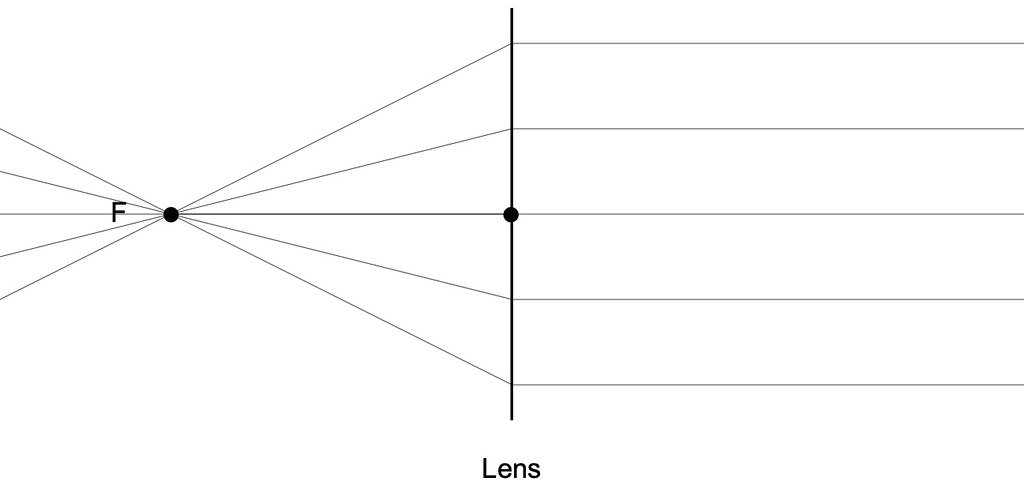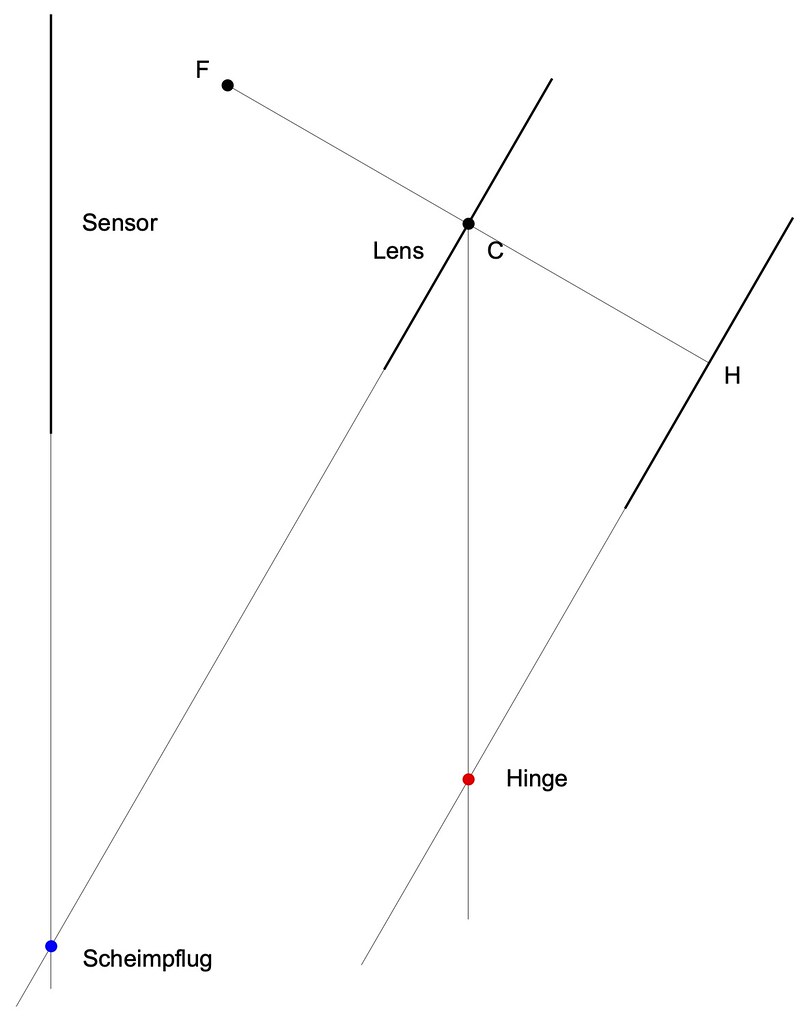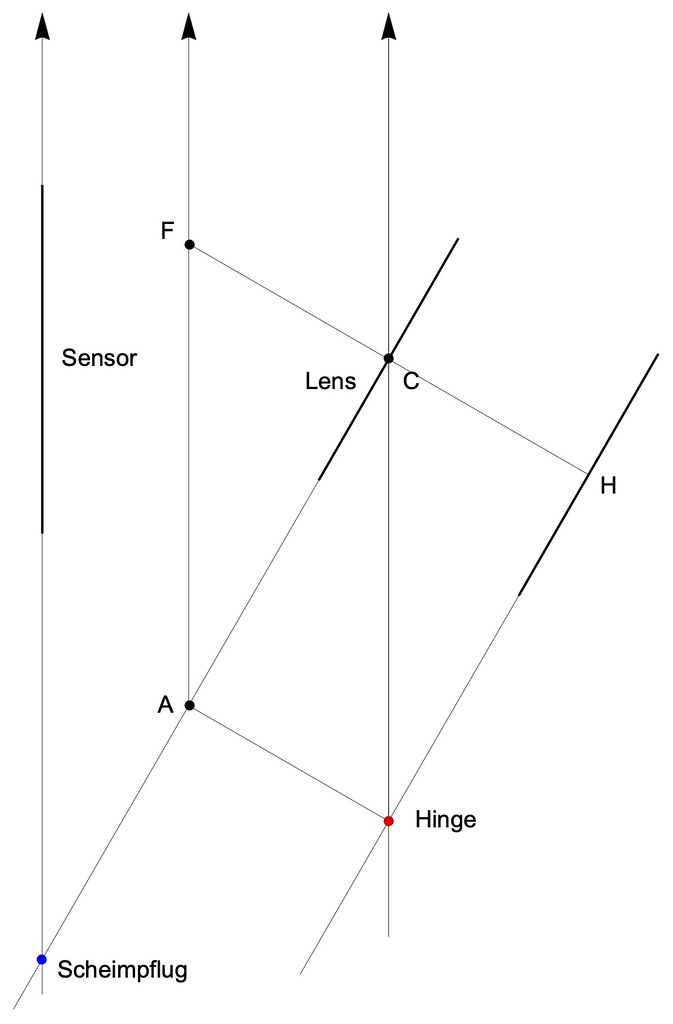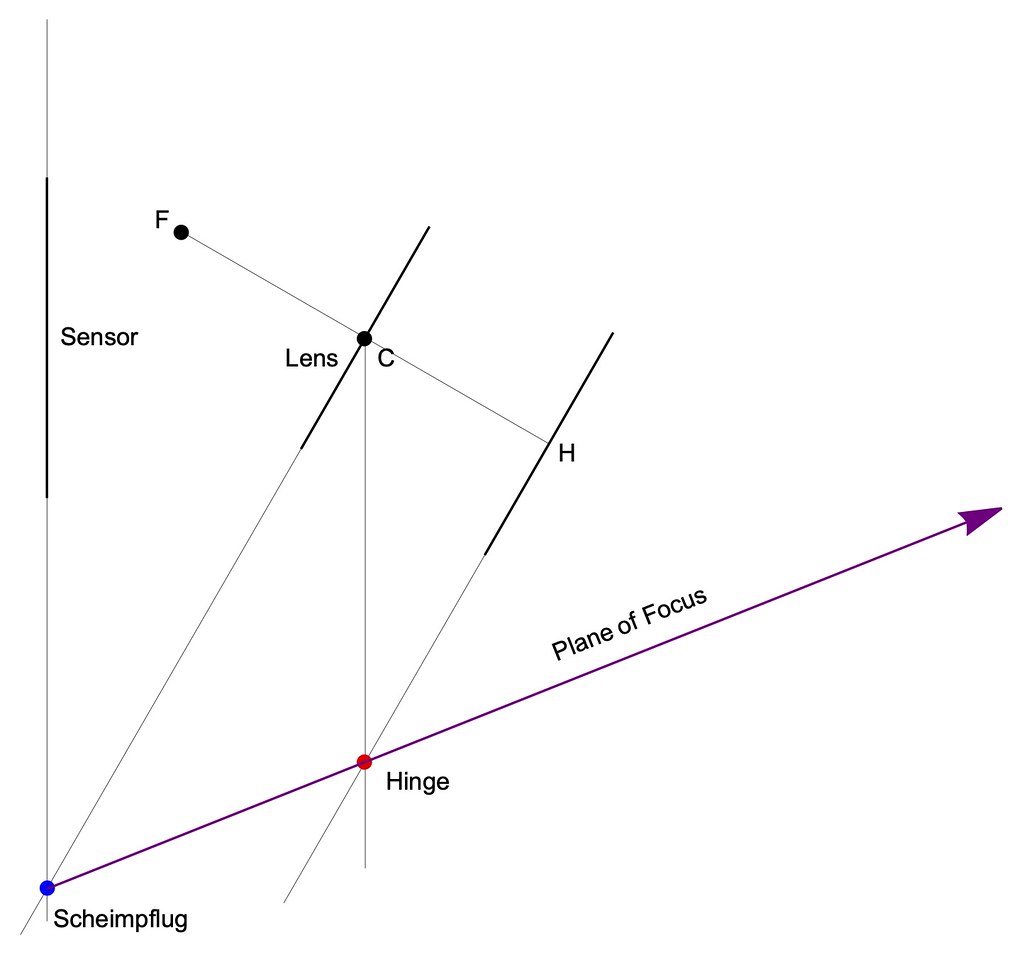MGrayson
Subscriber and Workshop Member
In Dave Chew's excellent article on using camera movements in the field, he concentrates on what actually happens to the focus plane (focus wedge, actually) as lens tilt and focus are adjusted. This is what a photographer needs to know.
Unfortunately, I'm a mathematician. Mathematicians care about three things: what is true, why it is true, and the proof that it's true. To publish papers and be famous (famous mathematician, now THERE'S an oxymoron), one only needs the "what" and the "proof". But some of us are absurdly attached to the "why".
I gave my "why" for tilting elsewhere, but it makes no reference to the two things that all other treatments treat as fundamental: Scheimpflug and the Hinge (bad rock group name?). The great thing about these entities is that they don't exist (or are hiding at infinity) for normal untilted lens/sensors. But if they DO exist, which is whenever the lens and sensor are not parallel, then they have a truly wonderful property. THEY ARE BOTH IN FOCUS. Good optics having no field curvature *cough*, we then know that the entire line between these two points is in focus.
All treatments tell you WHAT these points are: Scheimpflug is the intersection of the sensor plane and the lens plane (Lines in all the pictures. We're just doing tilt, no swings!). Did you ever think how a point ON THE SENSOR could be in focus? I mean, I guess they all are if you ignore the lens, but that's not a really useful fact. But how can a point ON THE LENS PLANE be in focus. Its light can't go through the lens. We'll get to that.
The harder point to describe, even if it's more useful (see Dave above), is the Hinge. The Hinge is the intersection of a vertical line through the lens center (we're keeping the sensor vertical and tilting the lens) and a weird line H which is parallel to the lens but one focal length in FRONT of it. Why is it called the Hinge? Because it doesn't depend on the sensor distance, and so as you rack the sensor back and forth, the Hinge doesn't move, and the plane of focus rotates around it as if it were ... a hinge.
Now the real world is a mess, so physicists to some extent, and mathematicians to a much greater extent, simplify it. (ASIDE: Physicists are very very bad about distinguishing their simplified models from reality, and so we get books on superstrings and the multiverse as if these are "real". They are no more real than the music of the spheres, which was a good theory 600 years ago.) So we simplify what a lens is and where focus is. These are close enough - and are necessary for the above mentioned rules to hold, so we'll use them.
A "Lens of focal length f" is a magical object. In our simplified world, it lies in a plane. Since we're looking at all this from the side, the lens will lie on a line. What is magical about it? Take a point P (more than distance f in front of the lens - we'll deal with closer points later). Then there is a point Q on the other side of the lens such that EVERY ray of light emanating from P that hits the lens will bend and then pass through Q. Wait, what was that about the focal length? If parallel light rays hit the lens (P is off at infinity), then Q is distance f from the lens plane.
Two facts (axioms) about the lens will let us find Q given P, and vice-versa (this is called "focusing"). One - any light ray passing through the center of the lens does not bend at all. Two - light rays entering the lens perpendicular to its plane will pass through the center line a distance f behind the lens. This very important point we call F. Aim the lens at the sun and this point F gets very very hot.. These two rules are enough to explain both Scheimpflug and the Hinge with surprisingly little effort. Suspension of disbelief? You betcha. Effort, not so much. Quick corollary - if a bunch of P's lie on a plane parallel to the lens, then all their Q's will too.
Scheimpflug is really easy, because if P is on the lens line, then Q and P are the same point. Wait, WHAT? How can they possibly be the same point? Because our definitions make sense under normal circumstances, but are also meaningful in these weird circumstances*. Take P on the lens line. The line through the center of the lens is just that very same lens line! There's no horizontal line to extend from P because it is already on the lens line. So the other line is the one from P to the focus point F ... well it started on the lens line, so it intersects the lens line (line through the center of the lens, too, in this case) at P. That intersection is the *definition* of Q, so P=Q. ANYWHERE the sensor line intersects the lens line is in focus! I always thought Scheimpflug was hard. It's a freaking tautology! Note: All theorems are tautologies - the trick is setting up the definitions correctly.
How about the Hinge? Here we get super sneaky. The universe is the same on both sides of the lens. Light rays travel the same in both directions. So if P is any point on the line H parallel to the lens and distance f in FRONT of it, then all the Q's will be infinitely far back. It's the same as focusing on the sun, but the sun is now BEHIND you. So why is the Hinge in focus? Take a laser pointer and move it along H but aim it at the lens center. There's a vertical sensor back there, but not being infinitely far away, the laser pointer is never in focus on the sensor. But now move the laser pointer down towards the Hinge. The spot on the sensor plane gets higher and higher. When the laser is directly below the center of the lens, the beam goes up to infinity, as it is now parallel to the sensor. If you think about vanishing points of railroad tracks, you can believe that parallel lines are said to meet at infinity. Indeed,, the laser pointer is focused at infinity "on" the sensor plane. Focused on the sensor plane is what it MEANS to be in focus, and so the Hinge is in focus, too.
So that's it. Scheimpflug in focus, Hinge in focus, so line between them is in focus. Now forget all this, read Dave again, and go take pictures.
Matt
*This is not cheating. Newton's law of gravitation stemmed from applying a rule that made sense for planets orbiting the sun and applying it to a rock orbiting the earth at head height. The acceleration on the rock turned out to be the same as the acceleration of dropping a rock. BANG! One of the best ideas anyone has ever had EVER.
Unfortunately, I'm a mathematician. Mathematicians care about three things: what is true, why it is true, and the proof that it's true. To publish papers and be famous (famous mathematician, now THERE'S an oxymoron), one only needs the "what" and the "proof". But some of us are absurdly attached to the "why".
I gave my "why" for tilting elsewhere, but it makes no reference to the two things that all other treatments treat as fundamental: Scheimpflug and the Hinge (bad rock group name?). The great thing about these entities is that they don't exist (or are hiding at infinity) for normal untilted lens/sensors. But if they DO exist, which is whenever the lens and sensor are not parallel, then they have a truly wonderful property. THEY ARE BOTH IN FOCUS. Good optics having no field curvature *cough*, we then know that the entire line between these two points is in focus.
All treatments tell you WHAT these points are: Scheimpflug is the intersection of the sensor plane and the lens plane (Lines in all the pictures. We're just doing tilt, no swings!). Did you ever think how a point ON THE SENSOR could be in focus? I mean, I guess they all are if you ignore the lens, but that's not a really useful fact. But how can a point ON THE LENS PLANE be in focus. Its light can't go through the lens. We'll get to that.
The harder point to describe, even if it's more useful (see Dave above), is the Hinge. The Hinge is the intersection of a vertical line through the lens center (we're keeping the sensor vertical and tilting the lens) and a weird line H which is parallel to the lens but one focal length in FRONT of it. Why is it called the Hinge? Because it doesn't depend on the sensor distance, and so as you rack the sensor back and forth, the Hinge doesn't move, and the plane of focus rotates around it as if it were ... a hinge.
Now the real world is a mess, so physicists to some extent, and mathematicians to a much greater extent, simplify it. (ASIDE: Physicists are very very bad about distinguishing their simplified models from reality, and so we get books on superstrings and the multiverse as if these are "real". They are no more real than the music of the spheres, which was a good theory 600 years ago.) So we simplify what a lens is and where focus is. These are close enough - and are necessary for the above mentioned rules to hold, so we'll use them.
A "Lens of focal length f" is a magical object. In our simplified world, it lies in a plane. Since we're looking at all this from the side, the lens will lie on a line. What is magical about it? Take a point P (more than distance f in front of the lens - we'll deal with closer points later). Then there is a point Q on the other side of the lens such that EVERY ray of light emanating from P that hits the lens will bend and then pass through Q. Wait, what was that about the focal length? If parallel light rays hit the lens (P is off at infinity), then Q is distance f from the lens plane.
Two facts (axioms) about the lens will let us find Q given P, and vice-versa (this is called "focusing"). One - any light ray passing through the center of the lens does not bend at all. Two - light rays entering the lens perpendicular to its plane will pass through the center line a distance f behind the lens. This very important point we call F. Aim the lens at the sun and this point F gets very very hot.. These two rules are enough to explain both Scheimpflug and the Hinge with surprisingly little effort. Suspension of disbelief? You betcha. Effort, not so much. Quick corollary - if a bunch of P's lie on a plane parallel to the lens, then all their Q's will too.
Scheimpflug is really easy, because if P is on the lens line, then Q and P are the same point. Wait, WHAT? How can they possibly be the same point? Because our definitions make sense under normal circumstances, but are also meaningful in these weird circumstances*. Take P on the lens line. The line through the center of the lens is just that very same lens line! There's no horizontal line to extend from P because it is already on the lens line. So the other line is the one from P to the focus point F ... well it started on the lens line, so it intersects the lens line (line through the center of the lens, too, in this case) at P. That intersection is the *definition* of Q, so P=Q. ANYWHERE the sensor line intersects the lens line is in focus! I always thought Scheimpflug was hard. It's a freaking tautology! Note: All theorems are tautologies - the trick is setting up the definitions correctly.
How about the Hinge? Here we get super sneaky. The universe is the same on both sides of the lens. Light rays travel the same in both directions. So if P is any point on the line H parallel to the lens and distance f in FRONT of it, then all the Q's will be infinitely far back. It's the same as focusing on the sun, but the sun is now BEHIND you. So why is the Hinge in focus? Take a laser pointer and move it along H but aim it at the lens center. There's a vertical sensor back there, but not being infinitely far away, the laser pointer is never in focus on the sensor. But now move the laser pointer down towards the Hinge. The spot on the sensor plane gets higher and higher. When the laser is directly below the center of the lens, the beam goes up to infinity, as it is now parallel to the sensor. If you think about vanishing points of railroad tracks, you can believe that parallel lines are said to meet at infinity. Indeed,, the laser pointer is focused at infinity "on" the sensor plane. Focused on the sensor plane is what it MEANS to be in focus, and so the Hinge is in focus, too.
So that's it. Scheimpflug in focus, Hinge in focus, so line between them is in focus. Now forget all this, read Dave again, and go take pictures.
Matt
*This is not cheating. Newton's law of gravitation stemmed from applying a rule that made sense for planets orbiting the sun and applying it to a rock orbiting the earth at head height. The acceleration on the rock turned out to be the same as the acceleration of dropping a rock. BANG! One of the best ideas anyone has ever had EVER.
Last edited:

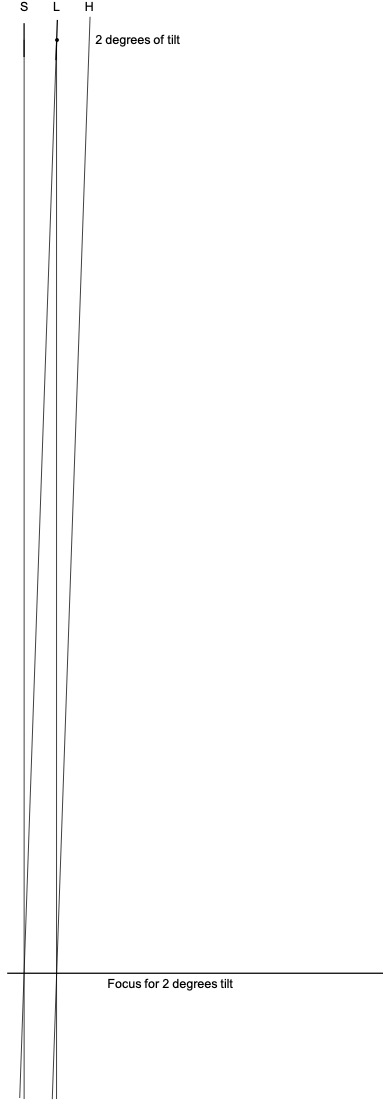 Untitled
Untitled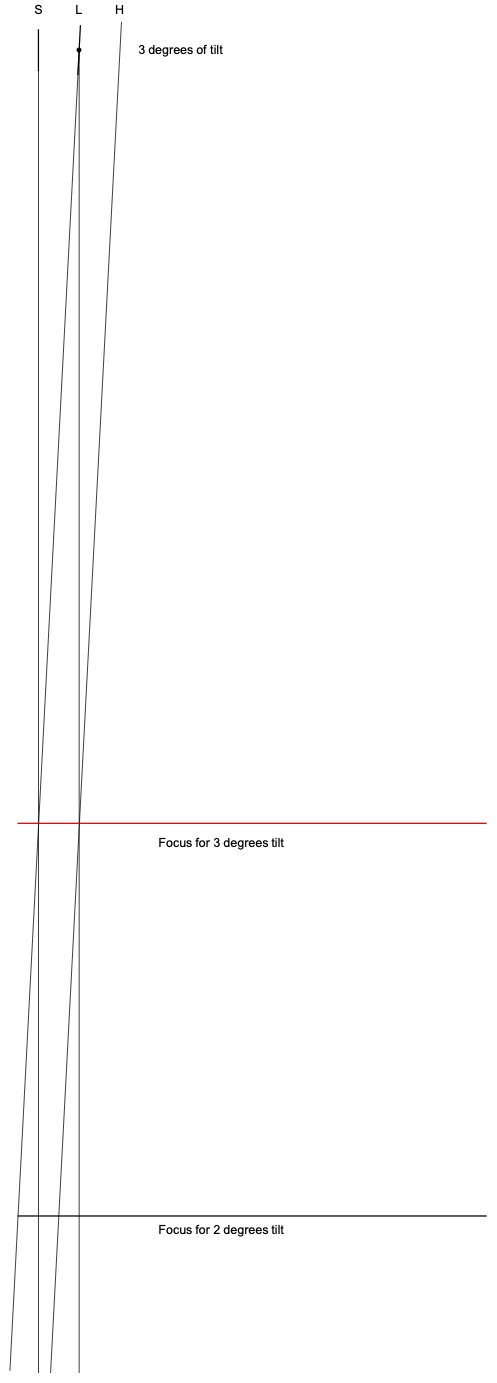 Untitled
Untitled Untitled
Untitled Untitled
Untitled
